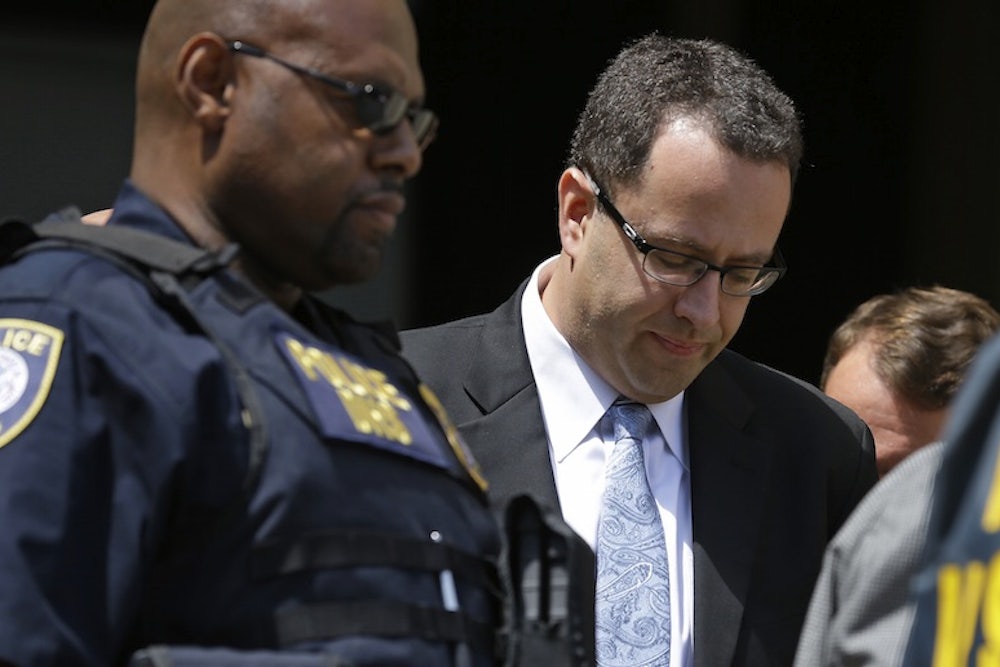Jared Fogle, the former Subway sandwiches spokesman, appeared in an Indianapolis court Wednesday on charges of possession of child pornography and paying to have sex with underage girls. As part of a plea bargain, Fogle will pay $1.4 million dollars—$100,000 to each of his 14 victims, whom prosecutor Steven DeBrota described as “now adults in desperate straits.” The money, DeBrota explained, will help Fogle’s victims pay for education, medical treatment, and counseling.
The payout's aims are not unlike those of VOCA, the 1984 Victims of Crime Act which funnels perpetrators’ bail bonds, penalty fees, and criminal fines into grants for victims’ services organizations. And it echoes the logic that brought VOCA into being in the first place: Victims lose something in the process of victimization, and they should not be forced to compensate for that loss themselves. But VOCA and court-determined payouts like Fogle's aren't nearly sufficient to address the long-term ramifications of victimization, especially in cases of sexual assault.
Along with the immediate physical and psychological issues stemming from the sexual assault, many victims are left with ongoing disorders that put them at risk for further complications down the line. Among the most concerning of all is the tendency for victims of sexual assault to turn to substance abuse in the months and years following their victimization. A 1997 study found that victims of sexual assault are three to ten times more likely than non-victims to struggle with substance abuse. A 1992 study found victims of rape are 26 times more likely to have two or more problems related to substance abuse, such as trouble at work, school, in relationships, or with the police.
The risk of succumbing to substance abuse as a result of sexual assault varies somewhat by demographic, with some groups in greater danger than others. Black women are already at greater risk of being sexually assaulted than their white female counterparts, but two studies illuminate the long-term consequences of their high-risk status as well. Consider this 2013 study that found that black women are more likely to develop substance abuse problems following a sexual assault than members of other racial demographics, and this 2010 study of black female survivors which suggested lower-income black women are at an even higher risk of developing substance abuse issues than the remainder of their cohort. Men and boys also suffer the ongoing impacts of sexual assault when it comes to sexual abuse: One study found that 80 percent of male victims of sexual assault battled alcoholism as adults, compared with 11 percent of male non-victims. The likelihood that a person will struggle with addiction differs, therefore, depending on his or her life situation. But the tendency of sexual assault to lead to substance abuse is something of a grim constant across the board.
Treating addiction can be costly, with some inpatient rehabilitation programs running between $7,500 to $120,000 per month—an expense that is not always covered by insurance. And the costs of leaving substance abuse untreated can be even greater.
Substance abuse is associated with a higher risk for sexual assault; this has the perverse effect of putting people who have already been sexually victimized at an elevated risk for being victimized again in the future. Substance abuse increases the likelihood of ending up in the criminal justice system. A 2002 analysis of local-jail inmates conducted by the Bureau of Justice Statistics found that some 68 percent of people held in local jails were dependent on drugs or alcohol; when it came to state prisons, the numbers were even more disturbing. “Illegal drug use was more common among abused state prison inmates than among those who said they were not abused,” the same BJS survey found. “An estimated 76 percent of abused men and 80 percent of abused women had used illegal drugs regularly, compared to 68 percent of men and 65 percent of women who had not been abused.” Histories of sexual victimization and substance abuse seem primed to put victims at a permanent, lifelong disadvantage, concluding sometimes in incarceration and often worse.
Settlements like Fogle’s, if they come in time, could assist victims in putting their lives back together before chronic substance abuse issues set in. But rarely are perpetrators as well-heeled as Fogle, and victims should not have to count on lucrative payouts from their abusers to offset the damages of abuse. The humane, cost-efficient solution is to make substance abuse treatment programs (both inpatient and otherwise) readily available at low or no cost. It will pay off: Studies have shown that each dollar spent on substance abuse treatment yields roughly seven dollars in benefits through increased productivity and reduced criminality. While the Affordable Care Act does cover substance abuse treatment, a universal healthcare system—the kind suggested by Democratic presidential hopeful Bernie Sanders, for example—inclusive of substance abuse treatment would expand coverage even further.
But even that's not enough. We must put an end to our highly punitive carceral approach to drug abuse, putting rehabilitation in the hands of healthcare providers rather than prison wardens. An increasing number of politicians from both parties agree on this point, though most of the talk of criminal-justice reform remains exactly that. For the sake of victims, let’s hope that talk turns into concrete policy.
